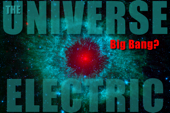Jack and the Electromagnetic Bean Stalk
07/20/08

The Beanstalk, Seen Jack?
Credit: Ken Childress
It seems that we are being fed fairy stories by our friends in
the astronomical community. How much longer will we permit the exclusion
of electric currents from the discussion of the cosmos, when their
byproducts, magnetic fields, are found so ubiquitously throughout
space?
In a
prior thunderblog, a simplified case for cosmic electrodynamics was
made. That commentary straightforwardly cited several references that
made clear the link between electric currents and magnetic fields, the
latter being byproducts of the former. It also noted that magnetic
fields have been observed ubiquitously throughout the known universe,
thus implying that the former MUST also by
definition be present.
The case for consideration of electric currents is made all the clearer
by concrete examples of astronomers confounded by magnetic fields and
their implications, as well as their failure to properly trace their
genesis to electric currents.
A recent
news release relates astronomers’ shock and awe at the fact that
galaxies assumed to be quite young and from the "early
universe" display strong magnetic fields like those of
"normal" galaxies today.
By analyzing light coming from distant galaxies at a time early in the
universe's history, astronomers were able to show that these galaxies
developed magnetic fields much sooner than expected. The finding may
force scientists to rethink their understanding of how magnetic fields
form inside galaxies.
It seems that astronomers have recognized that there is a problem with
the theory of galactic magnetic fields. That’s the first step in
resolving the issue. The next question is how they will
resolve the issue. Unfortunately, the current ideas seem less than
satisfactory.
Scientists think galactic magnetic fields start from tiny magnetic
seeds, perhaps created inside stars or quasars, and are then amplified
over time as the turbulent movement of galactic gas, stirred up by
stellar explosions, and the galaxy's rotation cause the magnetic
fields to grow. This standard picture, however, can only account for
strong magnetic fields that build up slowly over time. The new finding
means scientists must come up with an improved explanation for how
magnetic fields build up inside galaxies in the young universe such
as those Miniati and his team observed.
It seems astronomers are trying to sell us some magical "magnetic
seeds" that somehow grow over time (they’re not sure how),
much like the magic beanstalk in the famous children’s fairytale
Jack and the Beanstalk. As though magnetic fields are somehow
self-sufficient and independent of the motion of charged particles in
electric currents, be they in orbits around atomic nuclei, in wires or
in macroscopic conductors such as space plasmas.
Might not a more sensible solution be to recognize that, according to
definition, only electric currents give rise to
magnetic fields (as noted in the prior entry referenced above)?
It seems that all of the sciences except
astronomy and cosmology recognize and apply this concept routinely.
Once the intimate relationship between electric currents and their
byproduct magnetic fields is tacitly acknowledged in those areas of
research, perhaps what has up until now been "mysterious"
and "magical" will become a predictable consequence of
cosmic electrodynamics. It should be possible to trace magnetic
fields back to their source electric currents.
Wikipedia states the issue succinctly in its article on
electric current:
Electric current produces a magnetic field. The magnetic field can be
visualized as a pattern of circular field lines surrounding the [conductor].
Electric current can be directly measured with a galvanometer, but this
method involves breaking the circuit, which is sometimes inconvenient.
Current can also be measured without breaking the circuit by
detecting the magnetic field associated with the current.
[Emphasis added]
It bears repeating that electric currents produce
magnetic fields.
Likewise, sometimes breaking a circuit to insert a measuring device
or getting a galvanometer to the circuit (when the circuit may be
of galactic proportions) is inconvenient. When it is inconvenient
to measure the current directly, it can be measured indirectly by
measuring the associated magnetic fields. This is how it’s
done in the lab, and this is how it should be done in
space as well.
The World Health Organization also
states the
following about the relationship between electric currents and
magnetic fields:
... Magnetic fields are created when electric current
flows: the greater the current, the stronger the magnetic field. An
electric field will exist even when there is no current flowing. If
current does flow, the strength of the magnetic field will vary with
power consumption but the electric field strength will be constant.
(Extract from Electromagnetic fields published by the
WHO Regional Office for Europe in 1999 (Local authorities, health and
environment briefing pamphlet series; 32).
To again reiterate the important point here: Magnetic fields are created
when electric currents flow and the magnetic field strengths are a function
of electric current strength. Weak currents produce weak fields; strong
currents produce strong fields.
Where we see magnetic fields, with this new understanding in mind, it
should be possible to estimate and possibly map the associated electric
currents that produced them. The need for mysterious magically growing
"magnetic seeds" falls away in the face of an understanding
that magnetic fields are derived solely from electric currents.
Will this allow us to reverse-engineer Mother Nature’s blueprints? It
bears the potential to get us one step closer, if astronomers are willing
to hear an alternate retelling of their cherished stories.
Some day future generations may well say:
"… and finally astronomers, plasma physicists and electrical
engineers put their differences aside and engaged in a scientific
dialogue. From that day forward, the world of science lived happily
ever after!
The End."
Michael Gmirkin
Permalink to this article.
Public comment may be made on this article on the
Thunderbolts Forum/Thunderblogs (free membership required).
|





